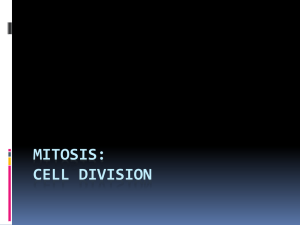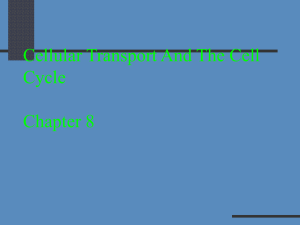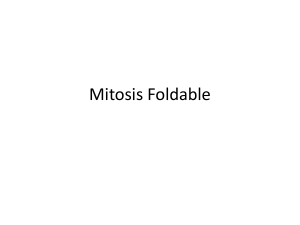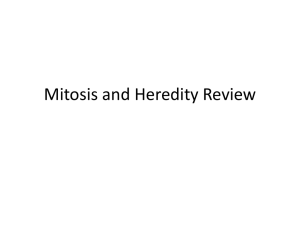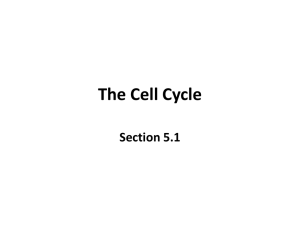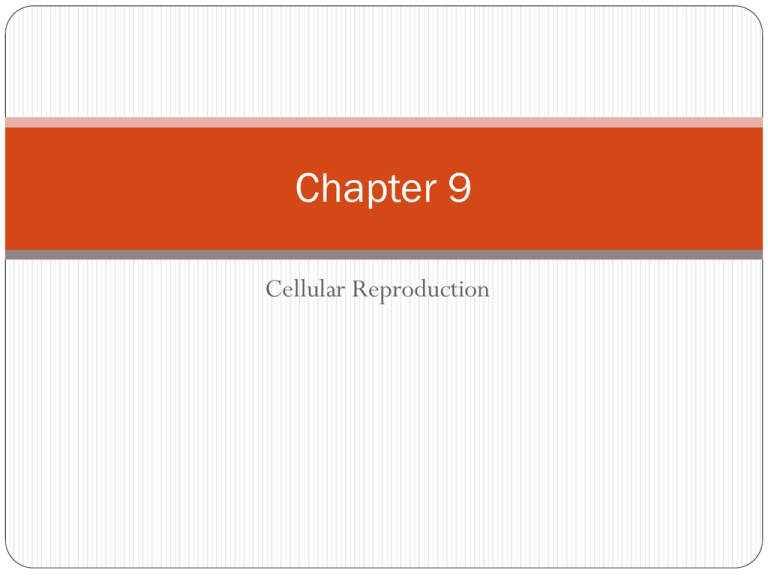
Chapter 9
Cellular Reproduction
Why do cells need to reproduce?
Why are cells so small?
What is Surface Area?
How is the surface area represented in a cell?
What is Volume?
What happens when the volume of a cell increases?
Mini-Lab 9.1
Investigate Cell Size
Cell
Cell Size
Cell 1
0.00002 m
Cell 2
0.001 m
Cell 3
2.5 cm (0.025 m)
Cell 4
30 cm (0.3 m)
Cell 5
15 m
Cell Surface Area
(L x W x 6)
Cell Volume
(L x W x H)
Cell
Cell Size
Cell Surface Area
(L x W x 6)
Cell Volume
(L x W x H)
SA :V
Cell 1
0.00002 m 0.0000000024
0.000000000000008
300, 000 : 1
Cell 2
0.001 m
0.000006
0.000000001
6000 : 1
Cell 3
2.5 cm
(0.025 m)
0.00375
0.000015625
240 : 1
Cell 4
30 cm
(0.30 m)
0.54
0.027
20 : 1
Cell 5
15 m
1350
3375
1 : 2.5
Cell
Cell Size
Cell 1
0.002 cm
Cell 2
0.1 cm
Cell 3
2.5 cm
Cell 4
30 cm
Cell 5
1500 cm
Cell Surface Area
(L x W x 6)
Cell Volume
(L x W x H)
SA :V
Cell
Cell Size
Cell Surface Area
(L x W x 6)
Cell Volume
(L x W x H)
SA :V
Cell 1
0.002 cm
0.000024
0.000000008
3000:1
Cell 2
0.1 cm
0.06
0.001
60:1
Cell 3
2.5 cm
37.5
15.625
2.4:1
Cell 4
30 cm
5400
27000
0.2:1
Cell 5
1500 cm
13,500,000
3,375,000,000
0.004:1
Limits to Cell Size
Smaller cells can better:
1. Exchange nutrients and expel wastes across the
plasma membrane.
◦
higher surface area to volume ratio (SA:V)
Transport substances within the cell.
2.
◦
◦
diffusion
motor proteins along cytoskeleton
Communicate instructions for cellular functions.
3.
◦
signal proteins
Events of the Cell Cycle
The Cell Cycle
The entire process of growing and dividing
Repeated continuously
Creates two cells from one cell
Normal animal cells –
takes 12-24 hours
3 main stages:
Interphase
Mitosis
Cytokinesis
Stages of
Cell Cycle
• Interphase
• Includes G1, S, G2
Followed by
Cell Division
Includes Mitosis and Cytokinesis
Interphase
Period of time during which the cell,
grows and develops,
carries out cellular functions,
and makes copies of its DNA in preparation for cell
division
3 parts (substages)
G1 – Gap 1
S – Synthesis
G2 – Gap 2
Stages of
Interphase
Gap 1 (G1)
Immediately after cell divides
Cell is growing and carrying out normal functions
Cell is preparing to replicate DNA
Synthesis Phase (S)
Cell copies its DNA in preparation for cell division
Gap 2 (G2)
Cell prepares for division of its nucleus
Makes proteins needed for cell division
Cell Division
When a cell reaches its maximum size, the
nucleus initiates cell division.
Cell division – the splitting of a single cell into
two cells.
‘Big Bang’ by M. Ormestad
©2006 All rights reserved
Cell Division
Cells divide so that an organism…
• can grow.
increases mass of organism
changes organism - differentiation
• can repair damaged cells and tissues.
regeneration
maintenance
• can reproduce.
Mitosis (Cell Division)
Stage of cell cycle where the nucleus divides
Includes four stages:
Prophase
Metaphase
Anaphase
Telophase
Cytokinesis (Cell Division)
Process where the cell’s cytoplasm divides and creates
a new cell
Chapter 9.2
Mitosis and Cytokinesis
Mitosis & Cytokinesis
Mitosis
the cell’s nuclear
material divides
4 parts (substages)
Cytokinesis
the cell cytoplasm
is divided into two
daughter cells
Genetic Material in the Cell
Question 1: In what stage of the cell cycle is the
DNA copied?
Answer 1: Synthesis
Question 2: Why is this important?
Answer 2: It prepares the cell for cell division
Question 3: How is DNA organized in a cell?
Hint:
Answer:
Chromosomes
Chromosomes
Structures that contain
the genetic material of
an organism
Only visible during
mitosis
Formed when
chromatin is wound
tightly around proteins
The DNA strands wraps
around proteins called
histones
The continue to wrap
around forming
nucleosomes
For most of the cell’s life, the DNA is contained in the
chromatin state
In cell division, chromatin organizes into distinct
chromosomes structures
Chromosome Formation http://www.youtube.com/watch?v=gbSIBhFwQ4s
Chromosome
Structure
Centromere
• Structure where the
sister chromatids are
attached
Sister chromatids
• Identical copies
• Copies created during synthesis of
interphase
• Attached at beginning of mitosis
Stages of Mitosis
Prophase
Metaphase
Anaphase
Telophase
Human cell undergoing cytokinesis from M. Pines, Inside the Cell: The New
Frontier of Medical Science. U.S. Dept. of Health, Education, and Welfare,
1978.
Prophase
1st stage
longest
Chromatin condenses into
chromsomes
Nuclear membrane disintegrates
Nucleolus disappears
Chromosomes attach to spindle
apparatus
End of Prophase
• Spindle apparatus forms
• Spindle fibers
• Centrioles
• Chromosomes attach to
spindle fibers
Metaphase
2nd stage
shortest
sister chromatids pulled
along the spindle
apparatus toward the
center of the cell
line up along the middle, or
equator
Anaphase
3rd stage
sister chromatids are pulled apart
spindle shorten
separates chromatids into two identical sets
Telophase
4th & last stage
“opposite of prophase”
Chromosomes arrive at poles of
spindle apparatus
decondense
Nuclear membrane and nucleolus
reform
Spindle apparatus is broken down or
recycled
May occur simultaneously with
cytokinesis
Another Look at Mitosis
Cytokinesis
Division of the cytoplasm into two daughter cells
Animal cells
microfilaments constrict
cell membrane pinches cell in two
Plant cells
construct a cell plate
new cell wall forms on either side of cell plate
Prokaryotic cells
DNA copies attach to plasma membrane
plasma membrane grows and pulls DNA copies
cell membrane pinches into two cells
apart
Mitosis in Motion
http://www.johnkyrk.com/mitosis.html
http://www.cellsalive.com/mitosis.htm
http://www.sci.sdsu.edu/multimedia/mitosis/navigator.html
http://www.sumanasinc.com/webcontent/animations/content/
mitosis.html
Chapter 9.3
Cell Cycle Regulation
Normal Cell Cycle
In eukaryotic cells, cell division driven by
A protein cyclin binding to an enzyme
cyclin-dependent kinase (CDK)
Normal Cell Cycle
Different cyclin/CDK combinations control different
activities in the cell cycle:
Signals the start of the cell cycle during G1
Signals DNA replication
Signals protein synthesis
Signals nuclear division
Signals the end of the cell cycle
Normal Cell Cycle
The cell cycle also has checkpoints to monitor the cycle and
stop it if something goes wrong
Abnormal Cell Cycle: Cancer
Cancer is uncontrolled cell growth that occurs when there
is a failure in the regulation of the cell cycle
Cancer cells crowd out other normal cells and can intrude
other organs; may lead to death of the organism from loss of
tissue
Abnormal Cell Cycle: Cancer
Cancer cells occur when
mutations takes place in
segments of DNA
Mutation cause changes in the
productions of proteins,
including cyclins
Substances that cause cancer
are carcinogens
Apoptosis
Normal, Programmed cell death
Occurs in cells that are damaged beyond repair
Can help protect cells from cancer
Stem Cells
Cells are designed for
specialized functions
Stem cells are
unspecialized cells that
can develop into
specialized cells
Two types of stem cells:
Embryonic
Adult
Stem Cells
The Nature of Stem Cells
http://learn.genetics.utah.edu/content/tech/stemcells/scintro/
Go, Go Stem Cells
http://learn.genetics.utah.edu/content/tech/stemcells/sctypes/



